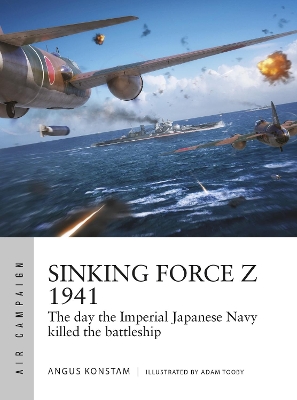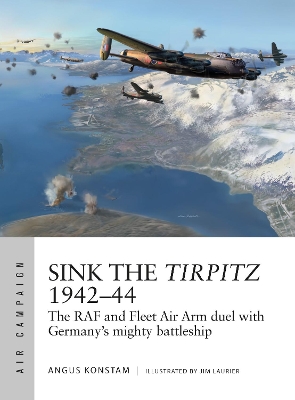Air Campaign
2 total works
A history and analysis of one of the most dramatic moments in both air power and naval history. With the sinking of HMS Prince of Wales and Repulse, no battleship was safe on the open ocean, and the aircraft took its crown as the most powerful maritime weapon
In late 1941, war was looming with Japan, and Britain's empire in southeast Asia was at risk. The British government decided to send Force Z, which included the state-of-the-art battleship Prince of Wales and the battlecruiser Repulse, to bolster the naval defences of Singapore, and provide a mighty naval deterrent to Japanese aggression. These two powerful ships arrived in Singapore on 2 December - five days before the Japanese attack on Pearl Harbor. But crucially, they lacked air cover. On 9 December Japanese scout planes detected Force Z's approach in the Gulf of Thailand. Unlike at Pearl Harbor, battleships at sea could manoeuvre, and their anti-aircraft defences were ready. But it did no good. The Japanese dive-bombers and torpedo-bombers were the most advanced in the world, and the battle was one-sided.
Strategically, the loss of Force Z was a colossal disaster for the British, and one that effectively marked the end of its empire in the East. But even more importantly, the sinking marked the last time that battleships were considered to be the masters of the ocean. From that day on, air power rather than big guns would be the deciding factor in naval warfare.
In late 1941, war was looming with Japan, and Britain's empire in southeast Asia was at risk. The British government decided to send Force Z, which included the state-of-the-art battleship Prince of Wales and the battlecruiser Repulse, to bolster the naval defences of Singapore, and provide a mighty naval deterrent to Japanese aggression. These two powerful ships arrived in Singapore on 2 December - five days before the Japanese attack on Pearl Harbor. But crucially, they lacked air cover. On 9 December Japanese scout planes detected Force Z's approach in the Gulf of Thailand. Unlike at Pearl Harbor, battleships at sea could manoeuvre, and their anti-aircraft defences were ready. But it did no good. The Japanese dive-bombers and torpedo-bombers were the most advanced in the world, and the battle was one-sided.
Strategically, the loss of Force Z was a colossal disaster for the British, and one that effectively marked the end of its empire in the East. But even more importantly, the sinking marked the last time that battleships were considered to be the masters of the ocean. From that day on, air power rather than big guns would be the deciding factor in naval warfare.
This is the story of an air campaign in which each bomb could dramatically influence the course of the war.
In January 1942, the powerful German battleship Tirpitz sailed into her new base in a Norwegian fjord, within easy reach of the Arctic Convoys. Her destruction suddenly became a top Allied priority. But sinking a modern and formidably armed battleship was no easy task, especially when she lay secure in a remote, mountainous fjord, protected by anti-torpedo nets, radar, flak guns and smoke generators.
This book charts the full, complex story of the air war against Tirpitz, from the Fleet Air Arm’s failed torpedo attack at sea, the RAF’s early Halifax raids, and the carrier-borne Barracuda airstrikes of Operations Mascot, Tungsten and Goodwood, to the three Tallboy attacks that finally crippled and sank her. With detailed maps and diagrams, it explains the aircraft and ordnance the British had to work with, the evolving strategic situation, and why the task was so difficult.
In January 1942, the powerful German battleship Tirpitz sailed into her new base in a Norwegian fjord, within easy reach of the Arctic Convoys. Her destruction suddenly became a top Allied priority. But sinking a modern and formidably armed battleship was no easy task, especially when she lay secure in a remote, mountainous fjord, protected by anti-torpedo nets, radar, flak guns and smoke generators.
This book charts the full, complex story of the air war against Tirpitz, from the Fleet Air Arm’s failed torpedo attack at sea, the RAF’s early Halifax raids, and the carrier-borne Barracuda airstrikes of Operations Mascot, Tungsten and Goodwood, to the three Tallboy attacks that finally crippled and sank her. With detailed maps and diagrams, it explains the aircraft and ordnance the British had to work with, the evolving strategic situation, and why the task was so difficult.

